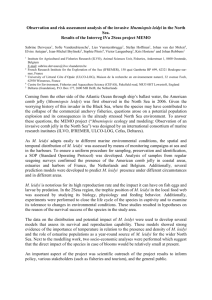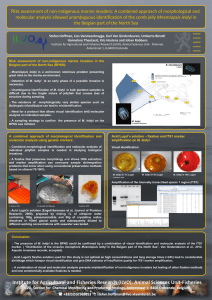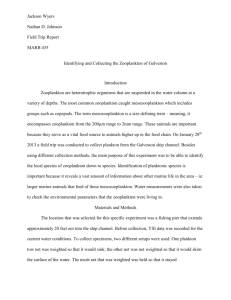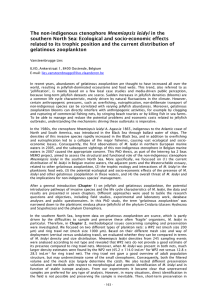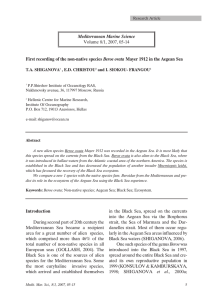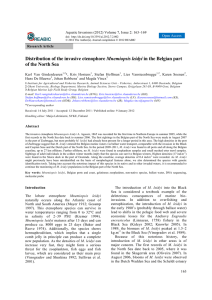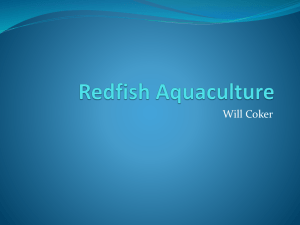Diapositive 1 - Black Sea SCENE
advertisement
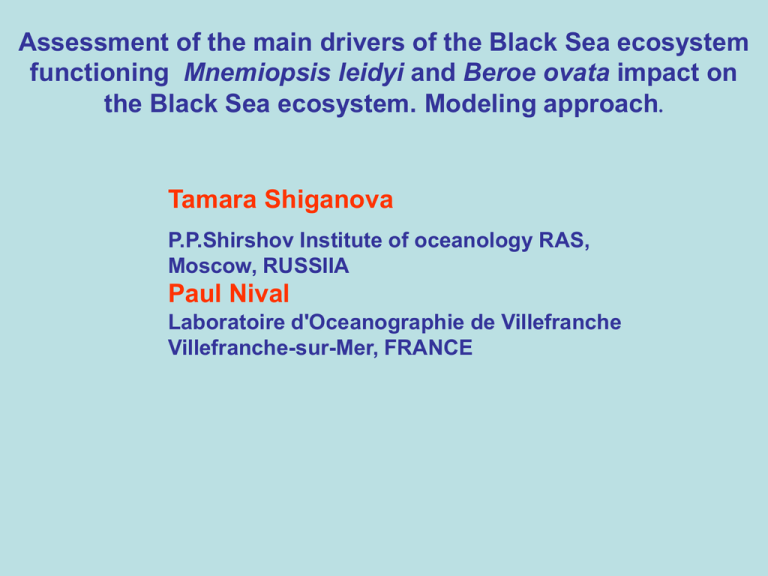
Assessment of the main drivers of the Black Sea ecosystem functioning Mnemiopsis leidyi and Beroe ovata impact on the Black Sea ecosystem. Modeling approach. Tamara Shiganova P.P.Shirshov Institute of oceanology RAS, Moscow, RUSSIIA Paul Nival Laboratoire d'Oceanographie de Villefranche Villefranche-sur-Mer, FRANCE Distribution of M. leidyi in the native and invaded areas Native area Invaded area Costello J. H., J. E. Purcell, K. M. Bahya, H. W. Mianzan & T. A. Shiganova, 2011 In the Black Sea, native gelatinous species belong to moderately cold-water species: the ctenophore Pleurobrachia pileus, scyphomedusa Aurelia aurita, and the pyrophyte alga Noctiluca scintillans. Two warm water invasive ctenophores arrived and established in the heated upper layer Cold water species Warm water species Subdivision of the gelatinous species in their relation to mean seasonal, annual and minimal winter SST: analyses of field data according to main component method ) Dispersal of Mnemiopsis leidyi in the Eurasian seas Mnemiopsis leidyi 2006 2007 2005 2006 2006 2007 2005 1988 2005 2009 1982 2009 1999 1990 1992 1993 2009 Population genetic analyses supported its invasion from the Gulf of Mexico (e.g., Tampa Bay) into the Black Sea, then secondary into the Dispersal of Beroe ovata in the Eurasian seas 2000 2005 1997 1997 2004 1999 2011 Beroe ovata Environmental data and Black Sea M.leidyi invasion in the seas of Eurasia Sea of Azov The dark area Corresponds to the period of Mnemiopsis leidyi Aegean Sea occurance (observations) Caspian Sea Baltic Sea After Shiganova et al., in press Interannual variation of M.leidyi and B.ovata in the Black Sea Abundance, ind.m-2 2500 M.leidyi,ind.m2 2000 2500 1200 1000 M.leidyi,ind.m2 2000 1500 800 B.ovata,ind.m2 1500 600 1000 1000 400 500 500 0 0 0 2008 2007 2006 2005 2004 2003 2002 2001 2000 1999 1998 1997 1996 1995 1994 1993 1992 1991 1990 1989 1988 1984 Years 200 Zooplankton are the main food of M.leidyi Change of interannual variability of edible zooplankton after appearance of invasive ctenophores in the inshore and offshore waters in August in the northeastern Black Sea Zooplankton in the offshore waters,ind.m2 2 450000 450000 400000 400000 350000 zooplankton,ind.m2 Zooplankton, ind.m -2 Zooplankton in the inshore waters,ind.m 500000 350000 300000 300000 250000 250000 200000 200000 150000 150000 100000 100000 50000 50000 0 0 VIII.2008 VIII.2007 Paracalanus parvus Acarthia clausi Pontella mediterrania Oikopleura dioica Larvae_Bivalvia Larvae_Decapoda Cirripedia Larvae Penilia avirostris Isopoda VIII.2006 IX.2005 VIII.2004 VIII.2003 IX.2002 IX.2000 VIII.1999 Calanus euxinus Pseudocalanus elongatus Oithona similis Oithona nana Parasagitta setosa Larvae_Polychaeta Larvae Gastropoda Cladocera without Penilia Centropages ponticus VIII.1998 VII.1996 VIII.1995 VIII.1994 VIII.1993 VIII.1989 VIII.2008 VIII.2007 Paracalanus parvus Acarthia clausi Pontella mediterranea Larvae_Polychaeta Larvae Gastropoda Parasagitta setosa Penilia avirostris Oikopleura dioica Years VIII.2006 VIII.2005 VIII.2004 VIII.2003 VIII.2002 VIII.2001 IX.2000 VIII.1999 VIII.1998 VII.1996 VIII.1995 VIII.1994 VIII.1993 VIII.1989 Calanus euxinus Pseudocalanus elongatus Oithona similis Larvae_Bivalvia Larvae_Decapoda Cirripedia Larvae Cladocera without Penilia Centropages ponticus Harpacticoida Mnemiopsis leidyi seasonal cycle in cold (1993) and warm (1994) year before B.ovata arrival Field data in the coastal area Warm year r=0,6-08, p<0,001 Cold year 8 9 9 8 8 8 7 7 6 6 5 5 4 4 3 3 2 2 9 1994 7 6 6 5 5 4 4 3 3 2 2 1 1 1 1 0 0 0 0 I II III IV V VI VII VIII IX X XI XII Mnemiopsis Zooplankton mnemiopsis,г.м-3 7 I II III IV V VI VII VIII IX X XI XII Mnemiopsis Zooplankton Before the arrival of B.ovata, M.leidyi abundance was controlled by temperature and zooplankton prey Zooplankton,g.m-3 1992 Zooplankton,mg.m-3 Mnemiopsis,g.m-3 9 30 2001 25 25 Temperature, Temperature, 15 10 C 0 20 15 10 5 5 0 0 20 40 60 80 100 120 140 160 180 200 220 240 260 280 300 320 340 360 500 Zooplankton 300 200 300 200 Mn.adult 1 Mn.Juv Mn.eggs Mn.larvae 220 200 180 160 140 A 120 100 E M.leidyi 80 60 Mnemiopsis, ind.m3 240 J L 40 20 40 60 40 60 80 300 250 200 150 0 80 100 120 148 160 180 200 220 240 250 260 266 270 280 300 320 340 350 260 240 240 220 220 200 200 180 160 140 120 100 80 100 120 140 160 180 200 220 240 260 280 300 320 340 360 80 60 40 20 20 0 20 40 60 80 100 120 140 160 180 200 220 240 260 280 300 320 340 360 0 L Ber.larva 60 J 50 40 30 E B.ovata 20 10 60 50 40 0 20 40 60 80 100 120 140 160 180 Days 200 220 240 260 280 300 320 340 360 80 100 120 140 160 180 200 220 240 260 280 300 320 340 360 70 60 50 40 30 20 20 10 10 0 0 60 80 30 A 40 90 70 Beroe, ind. m -3 Ber.eggs 70 20 100 80 Ber.Juv 100 115 139 162 168 169 200 220 234 252 280 300 320 340 360 100 Beroe, ind.m3 80 80 120 90 Ber.adult 1 60 140 100 90 40 160 40 0 100 20 180 60 0 20 350 260 0 0 400 0 20 96 101 120 140 166 210 235 236 237 249 254 264 276 300 320 340 360 Mnemiopsis, ind.m-3 80 500 450 100 50 0 60 260 Mnemiopsis, ind. m-3 Time (days) 550 400 0 40 20 40 60 80 100 120 140 160 180 200 220 240 260 280 300 320 340 360 600 100 100 Beroe,ind.m -3 0 Zooplankton, mg.m-3 500 Zooplankton,mg.m-3 Zooplankton, mg.m-3 600 20 10 Time (days) 600 0 15 0 0 20 40 60 80 100 120 140 160 180 200 220 240 260 280 300 320 340 360 20 5 Time (days 400 2008 25 C 0 0 C Temperature 20 0 30 2003 Temperature, 30 0 0 20 40 60 80 100 120 140 160 180 200 220 240 260 280 300 320 340 360 Days 0 20 40 60 80 100 120 140 160 180 200 220 240 260 280 300 320 340 360 Time (days) Interannual variability of phenology of ctenophores M. leidyi and B.ovata in the coastal area of the NE Black Sea 360 340 320 --- M.leidyi --- B.ovata 300 Time (days) 280 260 240 Time of appearance of B.ovata 220 Time of beginning reproduction of B.ovata 200 Time of appearance of M.leidyi Time of pick of reproduction of M.leidyi 180 160 140 120 1999 2000 2001 2002 appearance B.ovata Reproduction start of B.ovata Peak of B.ovata reproduction Disappearance B.ovata larvae 2003 2004 Year 2005 2006 2007 2008 Reproduction start of M.leidyi Peak of M.leidyi reproduction Disappearance M.leidyi larvae L Life stages and forcing factors J for M.leidyi and B.ovata A E Individual based modeling approach was used to take into account life cycle and physiological features E – eggs L-larva J-juvenale A-adult Temperature -mortality food 25 Forcing functions Zooplankton biomass biomasse zoopk (mmolN.m-3) 20 15 10 5 0 0 50 100 150 200 250 time (days) 300 350 400 200 250 temps days 300 350 400 30 Temperature Temperature (°C) 25 20 15 10 5 0 50 100 150 mortality 1,2 Mortality rate mortality rate 1 0,8 0,6 0,4 0,2 0 0 0,1 0,3 0,4 food concentration (m m ol N.m -3) 3 2.5 mmA1 2 2,5 1.5 1 0.5 0 40 30 0.4 0.3 20 0.2 10 0.1 0 0 Adult mortality (day-1) mmA1 Mortality rate 0,2 2 1,5 1 0,5 0 0 Model 5 10 15 20 Temperature (°C) 25 30 35 Prey – predator individual based model structure food M.leidyi Z E L A B.ovata J J L A Temperature E Age classes 1 2 no L 1 2 nL J 1 2 nJ 2 nA A process ageing 1 0% 1 50% 2 Age classes 100% no L 1 2 nL J 1 2 nJ 2 nA A process ageing 1 Change in stage duration depending on physiology (food, temperature) 25 fast length (units) 20 slow 15 10 5 0 0 10 20 30 40 50 age (days) egg larva juvenile Adult fast growing egg slow growing larva juvenile Adult n individus per unit unit of volume pervolume Number individuals Ontogenetic cycle of M.leidyi and B.ovata development 150 100 eggs larvae juveniles 50 adults old adults 0 0 5 10 15 temps days 20 25 30 Time (days) first adult first juvenile Model first larva first egg Reproduction rate Experiments Model 700 0.9 500 400 300 200 100 0 20 21 22 23 24 25 26 27 28 Temperature, 0C 180 160 egg.gWW -1,day 0.8 0.7 0.6 0.5 0.4 0.3 0.2 0.1 B.ovata 140 spawning rate coef. (d-1) WW,g,egg- 2.day-1 1 M.leidyi 600 0 120 5 10 15 20 temperature (°C) 100 80 60 40 20 0 20 21 22 23 24 Temperature, C 25 26 27 28 25 30 Ingestion rate Ingestion rate coefficient (0 – 1) experiment Model 1 0.9 3,5 ingestion rate coef. (d-1) Ration,DW.day -1 4 3 2,5 2 1,5 1 0,5 0 0 2000 4000 6000 8000 10000 12000 zooplankton,ind.m-3 0.8 0.7 0.6 0.5 0.4 0.3 0.2 0.1 0 0 minFood 0.05 0.1 0.15 0.2 available food concentration Food C2= (Food- minFood)/ (Kf+ (Food-minFood)) C2 = 0 when Food < minFood 0.25 0.3 Stage duration age to 50% transfer Stage duration (days 20 15 10 5 0 0 0.05 0.1 0.15 0.2 5 10 15 20 25 30 35 optimum conditions First stage: M.leidyi present B.ovata absent 400 L numbers (n m-3) 350 A 300 250 J 200 150 100 E 50 0 0 50 100 150 200 250 temps (days) 300 350 400 Second stage numbers (n m-3) 350 M.leidyi Model 300 250 L 200 150 A 100 E 50 0 0 50 100 150 J 200 250 300 350 400 temps (days) Simulation of input of B.ovata in surface water at time 200th day. M.leidyi develops a bloom, which is grazed by B.ovata Predation on larvae, juveniles and adult on M.leidyi makes them disappear 250 B.ovata 200 numbers (n m-3) B.ovata appears in surface water at time 200th day 400 L 150 J 100 E A 50 0 0 50 100 150 200 250 time (days) 300 350 400 Model Field observations 400 260 Mnemiopsis, ind. m -3 numbers (n m-3) 240 M.leidyi 350 300 L 250 200 150 A 100 180 160 A 140 120 100 E 80 60 40 J 0 0 20 40 60 80 100 120 140 160 180 200 220 240 260 280 300 320 340 360 Mn.adult 1 0 50 100 150 200 250 300 350 Time days Mn.ova Mn.Juv Mn.larvae 400 temps (days) 250 100 90 B.ovata 200 B.ovata 80 L 70 Beroe,ind.m -3 numbers (n m-3) L 20 50 0 M.leidyi 220 200 150 A 100 L 60 50 E 40 J A 30 20 10 50 0 0 0 0 50 100 150 200 250 time (days) 300 350 400 20 40 60 80 100 120 140 160 180 200 220 240 260 280 300 320 340 360 Time days Ber.adult 1 Ber.Juv Ber.ova Ber.larva Conclusions In present Black Sea ecosystem there is a bottom up control from zooplankton to its consumer Mnemiopsis leidyi and finally to its predator Beroe ovata. Annual changes in temperature and food availability are considered as the main factors that control these predators’ dynamics and their impact on pelagic ecosystem of the Black Sea. Both field data analyses and individual based modeling confirmed that, with appearance B. ovata that controlled M. leidyi population, a recovering shift of the ecosystem appeared but was controlled by climate forcing. Now in any case it is another ecosystem with two ctenophores that affected ecosystem but the time of high effect of M.leidyi is much shorter. Acknowledgement The research was performed in framework of project GK-0422 Thank you for attention
